
Tamil Jains are ethnic-Tamils from the Indian state of Tamil Nadu, who practice Jainism, chiefly the Digambara school. The Tamil Jain is a microcommunity of around 85,000, including both Tamil Jains and north Indian Jains settled in Tamil Nadu. They are predominantly scattered in northern Tamil Nadu, largely in the districts of Tiruvannamalai, Kanchipuram, Vellore, Villupuram, Ranipet and Kallakurichi. Early Tamil-Brahmi inscriptions in Tamil Nadu date to the third century BCE and describe the livelihoods of Tamil Jains. Samaṇar wrote much Tamil literature, including the important Sangam literature, such as the Nālaṭiyār, the Cilappatikaram, the Valayapathi and the Civaka Cintamani. Three of the five great epics of Tamil literature are attributed to Jains.

Sambandar, also referred to as Thirugnana Sambandar, Campantar or Jñāṉacampantar, was a Shaiva poet-saint of Tamil Nadu who lived sometime in the 7th century CE. He was a child prodigy who lived just 16 years. According to the Tamil Shaiva tradition, he composed an oeuvre of 16,000 hymns in complex meters, of which 383 (384) hymns with 4,181 stanzas have survived. These narrate an intense loving devotion (bhakti) to the Hindu god Shiva. The surviving compositions of Sambandar are preserved in the first three volumes of the Tirumurai, and provide a part of the philosophical foundation of Shaiva Siddhanta.
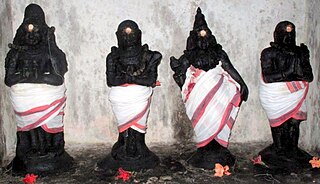
Tirumurai is a twelve-volume compendium of songs or hymns in praise of Shiva in the Tamil language from the 6th to the 11th century CE by various poets in Tamil Nadu. Nambiyandar Nambi compiled the first seven volumes by Appar, Sambandar, and Sundarar as Tevaram during the 12th century. During the course of time, a strong necessity was felt by scholars to compile Shaiva literature to accommodate other works. Tiruvasakam and Tirukovayar by Manickavasagar are included as the eighth, nine parts are compiled as the ninth Tirumurai out of which most are unknown, and the tenth as Tirumandiram by Tirumular, the famous Siddhar. The eleventh is compiled by Karaikal Ammaiyar, Cheraman Perumal and others. The contemporary Chola king was impressed by the work of Nambi and included Nambi's work in the eleventh Tirumurai. Sekkilar's Periya Puranam, composed a century later, contains the life depiction of all the 63 Nayanmars. The response for the work was so tremendous among Shaiva scholars and Kulothunga Chola II that it was included as the 12th Tirumurai. Tirumurai along with Vedas and Shaiva agamas form the basis of Shaiva Siddantha philosophy in South India and Sri Lanka.

Thiruvasagam is a volume of Tamil hymns composed by the ninth century Shaivite bhakti poet Manikkavasagar. It contains 51 compositions and constitutes the eighth volume of the Tirumurai, the sacred anthology of the Tamil Shaiva Siddhanta.

Appar also referred to as Thirunavukkarasar or Navukkarasar, was a seventh-century Tamil Śaiva poet-saint. Born in a peasant Śaiva family, raised as an orphan by his sister, he lived about 80 years and is generally placed sometime between 570 and 650 CE. Appar composed 4,900 devotional hymns to the god Shiva, out of which 313 have survived and are now canonized as the 4th to 6th volumes of Tirumurai. One of the most prominent of the sixty-three revered Nayanars, he was an older contemporary of Sambandar.
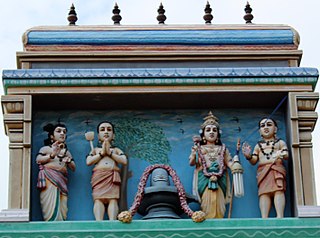
Sundarar, also referred to as Sundaramurthy Nayanar, Nambi Aarurar or Thambiran Thozhan, was an eighth-century poet-saint of Tamil Shaiva Siddhanta tradition of Hinduism. He is among the Tevaram trio, and one of the most prominent Nayanars, the Shaiva bhakti (devotional) poets of Tamil Nadu.

Manikkavasagar, was a 9th-century Tamil saint and poet who wrote Thiruvasagam, a book of Shaiva hymns. Speculated to have been a minister to the Pandya king Varagunavarman II, he lived in Madurai.

Arulmigu Murugan Temple, Thiruparankundram is a Hindu temple dedicated to the god Murugan at Thiruparankundram, Tamilnadu, India. It is regarded as one of the "First Houses of Murugan". The temple uses rock-cut architecture and is believed to have been built by the Pandyas during the 6th century. According to legend, Murugan slayed the demon Surapadman and married his consort Devasena at the temple. Murugan is also said to have worshipped his father Shiva at the site as Parangirinathar.

The Thevaram, also spelled Tevaram, denotes the first seven volumes of the twelve-volume collection Tirumurai, a Shaiva narrative of epic and Puranic heroes, as well as a hagiographic account of early Shaiva saints set in devotional poetry. The Thevaram volumes contain the works of the three most prominent Shaiva Tamil poets of the 7th and 8th centuries: Sambandar, Appar, and Sundarar. The three poets were not only involved in portraying their personal devotion to Shiva, but also engaged a community of believers through their songs. Their work is an important source for understanding the Shaiva Bhakti movement in the early medieval South India.
Thirunaraiyur Nambiyandar Nambi was an eleventh-century Shaiva scholar of Tamil Nadu in South India who compiled the hymns of Sambandar, Appar and Sundarar and was himself one of the authors of the eleventh volume of the canon of the Tamil liturgical poetry of Shiva, the Tirumurai.

Edaganathar Temple is a Hindu temple dedicated to the deity Shiva, located in Thiruvedagam, a village in Madurai district in the South Indian state of Tamil Nadu. The temple is located on the banks of Vaigai River. Shiva is worshipped as Edaganathar, and is represented by the lingam. His consort Parvati is depicted as Visalakshi. The presiding deity is revered in the 7th century Tamil Saiva canonical work, the Tevaram, written by Tamil saint poets known as the nayanars and classified as Paadal Petra Sthalam.
Koon Pandiyan was the nickname of a king who ruled Madurai around 7th century. Some historians identify him with the Pandyan king Arikesari Parankusa Maravarman.
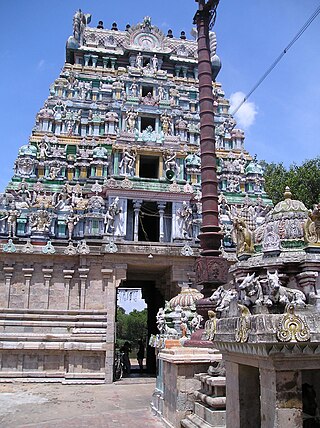
Kalyanasundaresar Temple, Nallur or Thirunallur is a Hindu temple dedicated to the deity Shiva in Nallur, Tamil Nadu, India. It is located 10 km (6.2 mi) away from Kumbakonam, 6 km (3.7 mi) east of Thirukkarugavur, and 30 km (19 mi) south of Thanjavur.

Vedaranyeswarar Temple is a Hindu temple dedicated to the god Shiva, located in the town of Vedaranyam in Tamil Nadu, India. Vedaranyeswarar is revered in the 7th century Tamil Shaiva canonical work, the Tevaram, written by Tamil saint poets known as the Nayanars and classified as Paadal Petra Sthalam. It is the only temple to have found mention in all the seven Thirumurais. The temple is famed for the legend between the saints Appar and Sambandar when the former sang to open the door while the latter sang to close the door.

Jainism has an extensive history in the Indian state of Tamil Nadu, although practiced by a minority of Tamils in contemporary times. According to the 2011 India Census, Jains represent 0.12% of the total population of Tamil Nadu, and are of the Digambara sect. Tamil Jains are primarily concentrated in northern Tamil Nadu, in the districts of Madurai, Viluppuram, Kanchipuram, Vellore, Tiruvannamalai, Cuddalore and Thanjavur.
Samanatham is the name of a panchayat village in the Madurai district of Tamil Nadu, India. It comes under the Thiruparankundram block."Sama Natham" a corrupt version of 'Samanar Rattham' or 'blood of Jains' is situated about six kilometers away from Madurai and a winding path among Acacia bushes and thorns leads one to a place worshipped as Mayandi temple. The place is isolated and is located in an eerie environment. But for the 10 foot trident and stone pillars with a hanging bell, there is nothing to suggest that it is a temple.
Mangayarkkarasiyar (Tamil:மங்கையர்க்கரசியார்) was one of the 63 Nayanmars or holy Saivite saints who are revered in South India. She is one among the only three women who attained this distinction. Her devotion to Lord Shiva is recounted in the hagiographic poem Periyapuranam compiled by Sekkizhar as well as in the Tiruthondar Thogai written by the poet-saint Sundarar.
Kulachirai Nayanar was a minister of the Pandyan king, Koon Pandyan, and one of the 63 Nayanars mentioned in the Periya Puranam.
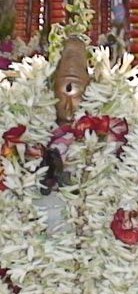
Murthi Nayanar, also spelt as Murthy Nayanar, Moorthy Nayanar and Murti Nayanar and also known as Murtti, is a Nayanar saint, venerated in the Hindu sect of Shaivism. He is generally counted as the fifteenth in the list of 63 Nayanars.
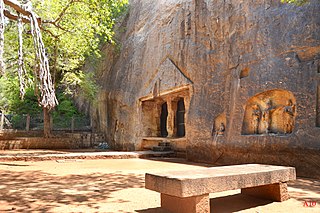
Thirupparankundram Rock-cut Cave and Inscription, also known as Umai Andar or Umaiyandar temple, is a rock cut cave temple with inscriptions at the foot of the Thirupparankundram rock hill's south face. It is located in the town of Thirupparankundram, about 10 kilometres (6.2 mi) southwest of Madurai city, Tamil Nadu, India. It consists of several layers of construction, the earliest is dated to the 8th-century early Pandya period, and the last to the 13th century.













